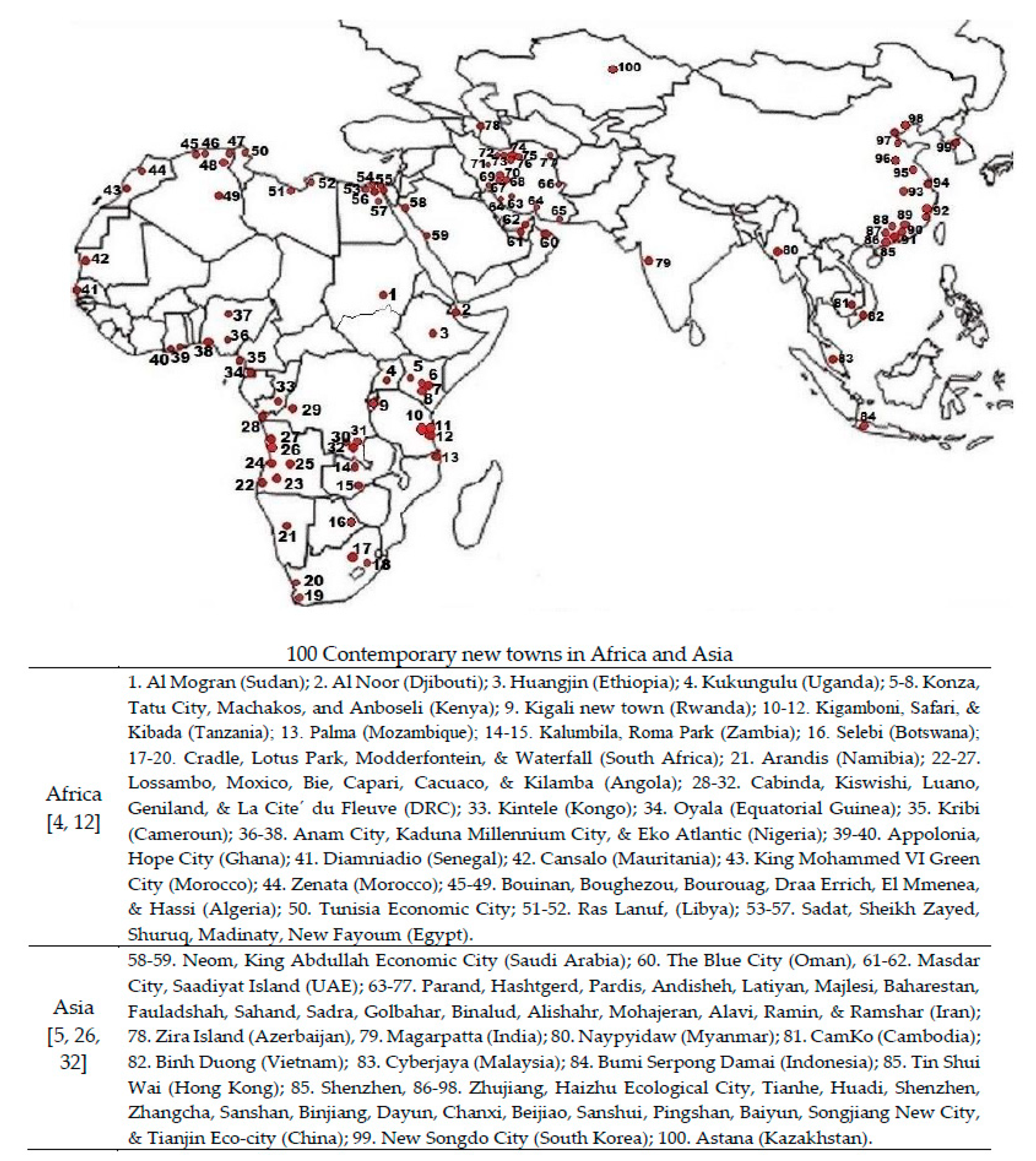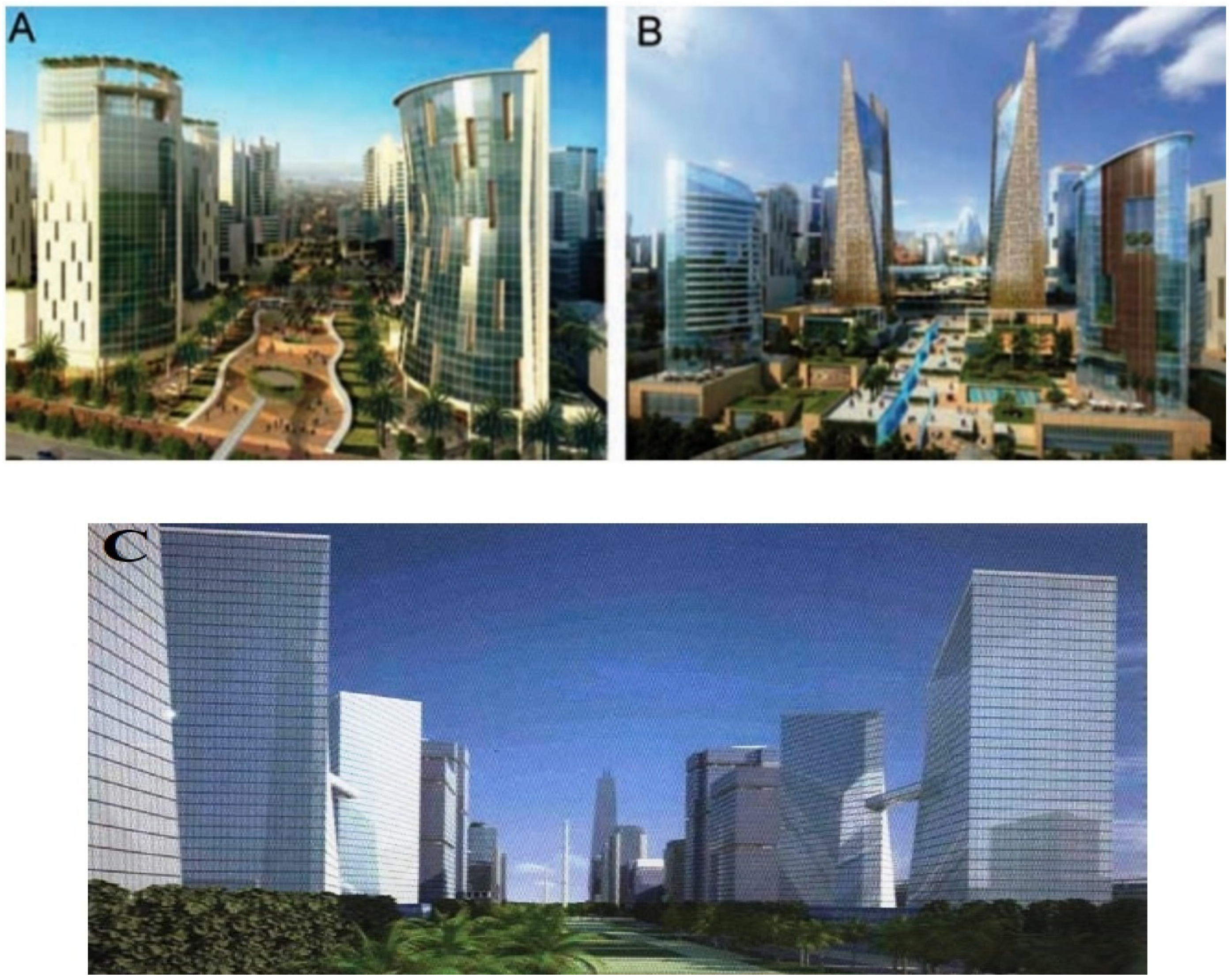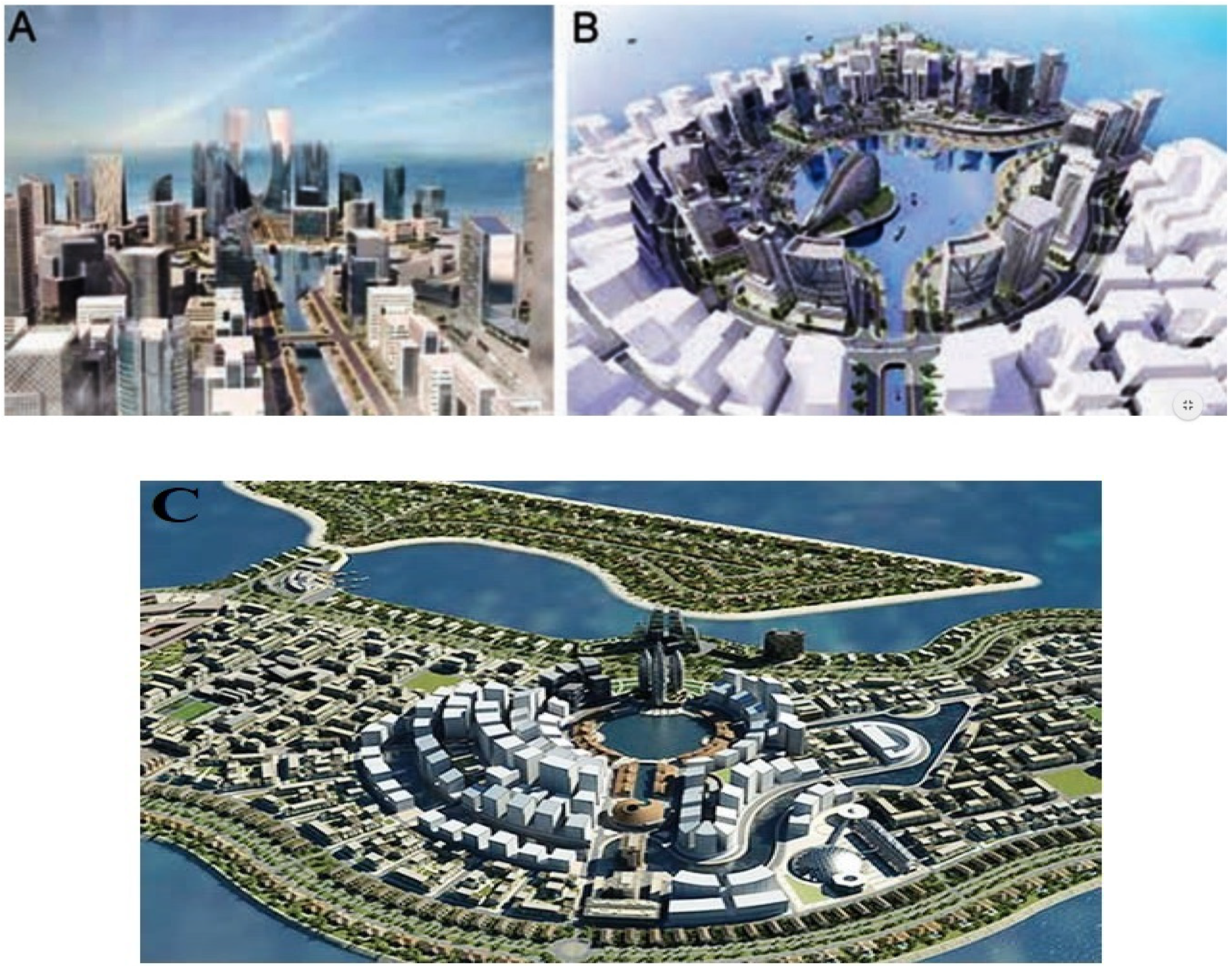Fostering Urban Sustainability through the Ecological Wisdom of Traditional Settlements
Abstract
1. Introduction
2. Methodology
3. Environmental Sustainability Challenges of CNTs in Africa and Asia
4. Ecological Wisdom of Traditional Settlements for Achieving a Sustainable Built Environment
4.1. Architecture
4.2. Urban Form
4.3. Green Infrastructure
5. Discussion and Recommendations
5.1. Sustainable Architecture and Land-Use Planning
5.2. Compact Urban Form and Mixed Land Uses
5.3. Green Infrastructure and Urban Agriculture
6. Conclusions
Author Contributions
Funding
Acknowledgments
Conflicts of Interest
References
- Seto, K.C.; Güneralp, B.; Hutyra, L.R. Global forecasts of urban expansion to 2030 and direct impacts on biodiversity and carbon pools. Proc. Natl. Acad. Sci. USA 2012, 109, 16083–16088. [Google Scholar] [CrossRef]
- United Nations. World Population Prospects 2019: Volume I: Comprehensive Tables; United Nations Department of Economic and Social Affairs: New York, NY, USA, 2019. [Google Scholar]
- World Bank. World Development Indicators 2016: Featuring the Sustainable Development Goals. The Highlights; World Bank Group: Washington, DC, USA, 2016. [Google Scholar]
- Cote-Roy, L.; Moser, S. Does Africa not deserve shiny new cities? The power of seductive rhetoric around new cities in Africa. Urban Stud. 2019, 56, 2391–2407. [Google Scholar] [CrossRef]
- Keeton, R. Rising in the East: Contemporary New Towns in Asia; International New Town Institute: Amsterdam, The Netherlands, 2011. [Google Scholar]
- Governa, F.; Sampieri, A. Urbanisation processes and new towns in contemporary China: A critical understanding from a decentred view. Urban Stud. 2020, 57, 366–382. [Google Scholar] [CrossRef]
- Keeton, R.; Nijhuis, S. Spatial challenges in contemporary African New Towns and potentials for alternative planning strategies. Int. Plan. Stud. 2019, 24, 218–234. [Google Scholar] [CrossRef]
- Abubakar, I.R.; Doan, P.L. New towns in Africa: Modernity and/or Decentralization? In Proceedings of the 53rd African Studies Association Annual Meeting. San Francisco, CA, USA, 18–21 November 2010. [Google Scholar]
- Grant, R. Sustainable African urban futures: Stocktaking and critical reflection on proposed urban projects. Am. Behav. Sci. 2015, 59, 294–310. [Google Scholar] [CrossRef]
- Herbert, C.W.; Murray, M.J. Building from scratch: New cities, privatized urbanism and the spatial restructuring of Johannesburg after apartheid. Int. J. Urban Reg. Res. 2015, 39, 471–494. [Google Scholar] [CrossRef]
- Abubakar, I.R.; Doan, P.L. Building new capital cities in Africa: Lessons for new satellite towns in developing countries. Afr. Stud. 2017, 76, 546–565. [Google Scholar] [CrossRef]
- Watson, V. African urban fantasies: Dreams or nightmares? Environ. Urban. 2014, 26, 215–231. [Google Scholar] [CrossRef]
- Brill, F.; Reboredo, R. Failed fantasies in a South African context: The case of Modderfontein, Johannesburg. Urban Forum 2019, 30, 171–189. [Google Scholar] [CrossRef]
- Cain, A. African urban fantasies: Past lessons and emerging realities. Environ. Urban. 2014, 26, 561–567. [Google Scholar] [CrossRef]
- Van Noorloos, F.; Kloosterboer, M. Africa’s new cities: The contested future of urbanisation. Urban Stud. 2018, 55, 1223–1241. [Google Scholar] [CrossRef] [PubMed]
- Abubakar, I.R. Governance Challenges in African Urban Fantasies. In Land Issues for Urban Governance in Sub-Saharan Africa; Home, R., Ed.; Springer Nature: Cham, Switzerland, 2021; pp. 155–169. [Google Scholar]
- Bhan, G. The real lives of urban fantasies. Environ. Urban. 2014, 26, 232–235. [Google Scholar] [CrossRef]
- Moser, S. New cities: Old wine in new bottles? Dialogues Hum. Geogr. 2015, 5, 31–35. [Google Scholar] [CrossRef]
- Patten, D.T. The role of ecological wisdom in managing for sustainable interdependent urban and natural ecosystems. Landsc. Urban Plan. 2016, 155, 3–10. [Google Scholar] [CrossRef]
- Wang, X.; Palazzo, D.; Carper, M. Ecological wisdom as an emerging field of scholarly inquiry in urban planning and design. Landsc. Urban Plan. 2016, 155, 100–107. [Google Scholar] [CrossRef]
- Abubakar, I.R.; Bununu, Y.A. Low carbon city: Strategies and case studies. In Sustainable Cities and Communities. Encyclopedia of Sustainability in Higher Education; Springer Nature: Cham, Switzerland, 2020; pp. 366–376. [Google Scholar]
- Hasan, M.A.; Abubakar, I.R.; Rahman, S.M.; Aina, Y.A.; Chowdhury, M.M.I.; Khondaker, A.N. The synergy between climate change policies and national development goals: Implications for sustainability. J. Clean. Prod. 2020, 249, 119369. [Google Scholar] [CrossRef]
- Alshuwaikhat, H.M.; Abubakar, I. Towards a sustainable urban environmental management approach (SUEMA): Incorporating environmental management with strategic environmental assessment (SEA). J. Environ. Plan. Manag. 2007, 50, 257–270. [Google Scholar] [CrossRef]
- Costanza, R.; Graumlich, L.; Steffen, W.; Crumley, C.; Dearing, J.; Hibbard, K.; Leemans, R.; Redman, C.; Schimel, D. Sustainability or Collapse: What Can We Learn from Integrating the History of Humans and the Rest of Nature. AMBIO 2007, 36, 522–527. [Google Scholar] [CrossRef]
- Campbell, S. Green Cities, Growing Cities, Just Cities? Urban Planning and the Contradictions of Sustainable Development. J. Am. Plan. Assoc. 2007, 62, 296–312. [Google Scholar] [CrossRef]
- Song, Y.; Stead, D.; de Jong, M. New Town Development and Sustainable Transition under Urban Entrepreneurialism in China. Sustainability 2020, 12, 5179. [Google Scholar] [CrossRef]
- Ye, Y.E.; Van Nes, A. The spatial flaws of new towns: Morphological comparison between a Chinese new and old town through the application of space syntax, spacematrix and mixed use index. ITU AZ J. Fac. Archit. (ITU Derg. A) 2014, 11, 1–20. [Google Scholar]
- Firman, T. New town development in Jakarta Metropolitan Region: A perspective of spatial segregation. Habitat Int. 2004, 28, 349–368. [Google Scholar] [CrossRef]
- Rumbach, A. Do new towns increase disaster risk? Evidence from Kolkata, India. Habitat Int. 2014, 43, 117–124. [Google Scholar] [CrossRef]
- Lau, J.C.Y. Spatial mismatch and the affordability of public transport for the poor in Singapore’s new towns. Cities 2011, 28, 230–237. [Google Scholar]
- Zamani, B.; Arefi, M. Iranian new towns and their urban management issues: A critical review of influential actors and factors. Cities 2013, 30, 105–112. [Google Scholar] [CrossRef]
- Ziari, K. The planning and functioning of new towns in Iran. Cities 2006, 23, 412–422. [Google Scholar] [CrossRef]
- Stewart, D.J. Cities in the desert: The Egyptian new-town program. Ann. Assoc. Am. Geogr. 1996, 86, 459–480. [Google Scholar] [CrossRef]
- Kwak, Y.; Park, C.; Deal, B. Discerning the success of sustainable planning: A comparative analysis of urban heat island dynamics in Korean new towns. Sustain. Cities Soc. 2020, 61, 102341. [Google Scholar] [CrossRef]
- Wu, T.; Yang, B.; Zhang, C. China’s New Town: 1979–2009. J. Urban Reg. Plan. 2011, 2, 19–43. [Google Scholar]
- Tan, X. New-town policy and development in China. Chin. Econ. 2010, 43, 47–58. [Google Scholar] [CrossRef]
- Cai, X.; De Meulder, B.; Lin, Y.; Sun, H. New Towns’ Planning and Construction in the Pre-Urbanization or Post-Urbanization Period: A Case Study of the New Towns’ Development Process of Beijing. Sustainability 2020, 12, 3721. [Google Scholar] [CrossRef]
- Wang, H.; Fan, J. Influence of Urban Development Stage of Beijing on the Development of New Towns. City Plan. Rev. 2007, 31, 20–24. [Google Scholar]
- Li, Y. The Rises and Falls of New Towns in Japan: History and Insights for China. Urban Plan. Int. 2017, 32, 18–25. [Google Scholar] [CrossRef]
- Yokohari, M.; Amemiya, M.; Amati, M. The history and future directions of greenways in Japanese New Towns. Landsc. Urban Plan. 2006, 76, 210–222. [Google Scholar] [CrossRef]
- Serghides, D.K. The wisdom of Mediterranean traditional architecture versus contemporary architecture—The energy challenge. Open Constr. Build. Tech. J. 2010, 4, 29–38. [Google Scholar] [CrossRef]
- Rashid, M.; Ara, D.R. Modernity in tradition: Reflections on building design and technology in the Asian vernacular. Front. Archit. Res. 2015, 4, 46–55. [Google Scholar] [CrossRef]
- Guttmann-Bond, E. Sustainability out of the past: How archaeology can save the planet. World Archaeol. 2010, 42, 355–366. [Google Scholar] [CrossRef]
- Wan, L.; Ng, E. Assessing the Sustainability of the Built Environment in Mountainous Rural Villages in Southwest China. Mt. Res. Dev. 2016, 36, 4. [Google Scholar] [CrossRef]
- Kakoty, S. Ecology, sustainability and traditional wisdom. J. Clean. Prod. 2018, 172, 3215–3224. [Google Scholar] [CrossRef]
- Chowdhury, M.M.I.; Rahman, S.M.; Abubakar, I.R.; Aina, Y.A.; Hasan, M.A.; Khondaker, A.N. A review of policies and initiatives for climate change mitigation and environmental sustainability in Bangladesh. Environ. Dev. Sustain. 2020, 7, 1–29. [Google Scholar] [CrossRef]
- Oshima, K.T. Rediscovering Japanese urban space in a world context. J. Urban Hist. 2016, 42, 623–633. [Google Scholar] [CrossRef]
- AlQahtany, A.M.; Abubakar, I.R. Public perception and attitudes to disaster risks in a coastal metropolis of Saudi Arabia. Int. J. Disaster Risk Reduct. 2020, 44, 101422. [Google Scholar] [CrossRef] [PubMed]
- Buell, L. Humble abodes of pre/industrial environmental memory: Thoreau, Stowe, Engels, and others. South Cent. Rev. 2018, 35, 12–25. [Google Scholar] [CrossRef]
- Momete, D.C. Sustainable development and its concrete implications: From an ancient wisdom to a modern fashion. In Proceedings of the 11th WSEAS International Conference on environment, ecosystems and development, Brasov, Romania, 1 June 2013; pp. 252–257. [Google Scholar]
- Wah, L. Ancient wisdom in modern design. Manag. Rev. 1998, 87, 13. [Google Scholar]
- Dhingra, M.; Chattopadhyay, S. Advancing smartness of traditional settlements-case analysis of Indian and Arab old cities. Int. J. Sustain. Built Environ. 2016, 5, 549–563. [Google Scholar] [CrossRef]
- Smith, M.E. The archaeological study of neighborhoods and districts in ancient cities. J. Anthropol. Archaeol. 2010, 29, 137–154. [Google Scholar] [CrossRef]
- Widodo, J. Urban Environment and Human Behaviour: Learning from History and Local Wisdom. Procedia Soc. Behav. Sci. 2012, 42, 6–11. [Google Scholar] [CrossRef]
- Abubakar, I.R.; Aina, Y.A. The prospects and challenges of developing more inclusive, safe, resilient, and sustainable cities in Nigeria. Land Use Policy 2019, 87, 104105. [Google Scholar] [CrossRef]
- Dano, U.L.; Balogun, A.; Abubakar, I.R.; Aina, Y.A. Transformative urban governance: Confronting urbanization challenges with geospatial technologies in Lagos Metropolitan Area. Geo. J. 2020, 85, 1039–1056. [Google Scholar]
- Whiteman, G.; Cooper, W.H. Ecological embeddedness. Acad. Manag. J. 2000, 43, 1265–1282. [Google Scholar]
- Kim, D.K. The natural environment control system of Korean traditional architecture: Comparison with Korean contemporary architecture. Build. Environ. 2006, 41, 1905–1912. [Google Scholar] [CrossRef]
- Barthel, S.; Isendahl, C. Urban gardens, Agriculture, and water management: Sources of resilience for long-term food security in cities. Ecol. Econ. 2013, 86, 224–234. [Google Scholar] [CrossRef]
- Mazraeh, H.M.; Pazhouhanfar, M. Effects of vernacular architecture structure on urban sustainability case study: Qeshm Island, Iran. Front. Archit. Res. 2018, 7, 11–24. [Google Scholar] [CrossRef]
- Guo, X.; Wang, J.P. Study of traditional architectural form adapt to the mountain environment research—Zhang Jiata ancient Village in Fangshan county of Shanxi. Appl. Mech. Mater. 2014, 477, 1144–1147. [Google Scholar] [CrossRef]
- Okubo, T. Traditional wisdom for disaster mitigation in history of Japanese Architectures and historic cities. J. Cult. Herit. 2016, 20, 715–724. [Google Scholar] [CrossRef]
- Bayoumi, O.A.M. Nubian Vernacular architecture & contemporary Aswan buildings’ enhancement. Alex. Eng. J. 2018, 57, 875–883. [Google Scholar]
- Shaowen, H.; Hanqi, H. Ecological Cultures of Traditional Hani Villages. J. Landsc. Res. 2017, 6, 87–93. [Google Scholar]
- Abubakar, I.R.; Dano, U.L. Sustainable urban planning strategies for mitigating climate change in Saudi Arabia. Environ. Dev. Sustain. 2020, 22, 5129–5152. [Google Scholar] [CrossRef]
- Jabareen, Y.R. Sustainable urban forms: Their typologies, models, and concepts. J. Plan. Educ. Res. 2006, 26, 38–52. [Google Scholar] [CrossRef]
- Lin, J.; Cai, J.; Han, Y.; Liu, J. Identifying the conditions for rural sustainability through place-based culture: Applying the CIPM and CDPM models into Meibei ancient village. Sustainability 2017, 9, 1334. [Google Scholar] [CrossRef]
- Smith, M.E. Form and meaning in the earliest cities: A new approach to ancient urban planning. J. Plan. Hist. 2007, 6, 3–47. [Google Scholar] [CrossRef]
- Yassin, H.H. Livable city: An approach to pedestrianization through tactical urbanism. Alex. Eng. J. 2019, 58, 251–259. [Google Scholar] [CrossRef]
- Sharifi, A.; Murayama, A. Changes in the traditional urban form and the social sustainability of contemporary cities: A case study of Iranian cities. Habitat Int. 2013, 38, 126–134. [Google Scholar] [CrossRef]
- King, A. Avoiding ecological surprise: Lessons from long-standing communities. Acad. Manag. Rev. 1995, 20, 961–985. [Google Scholar] [CrossRef]
- Chu, Y.C.; Hsu, M.F.; Hsieh, C.M. An example of ecological wisdom in historical settlement: The wind environment of Huazhai village in Taiwan. J. Asian Archit. Build. Eng. 2017, 16, 463–470. [Google Scholar] [CrossRef]
- Zheng, S.; Han, B.; Wang, D.; Ouyang, Z. Ecological Wisdom and Inspiration Underlying the Planning and Construction of Ancient Human Settlements-Case Study of Hongcun UNESCO World Heritage Site in China. Sustainability 2018, 10, 1345. [Google Scholar] [CrossRef]
- Lin, Y.; Weichu, H. Spatial Characteristics of Ancient Villages in Western Beijing Based on ASTER GDEM Data. J. Landsc. Res. 2018, 10, 128–134. [Google Scholar]
- Ramzy, N.S. Morphological logic in historical settlements: Space syntax analyses of residential districts at Mohenjo-Daro, Kahun and Ur. Urban Design Int. 2016, 21, 41–54. [Google Scholar] [CrossRef]
- Siti Rukayah, R.; Puguh, D.R.; Susilo, E.S.; Indraswara, M.S. Local Wisdom of the Native Settlement as A Main Gate in the Northern Axis of Javanese City Center in Semarang. In IOP Conference Series: Earth and Environmental Science; IOP Publishing: Bristol, UK, 2018; Volume 152. [Google Scholar]
- Zacharias, J.; Lei, Y. Villages at the urban fringe–the social dynamics of Xiaozhou. J. Rural Stud. 2016, 47, 650–656. [Google Scholar] [CrossRef]
- Ranaweera, M.P. Sustainable development, ancient wisdom and Sri Lankan technology. In Proceedings of the International Conference on Sustainable Built Environment (ICSBE-2010), Kandy, Sri Lanka, 14–26 December 2010. [Google Scholar]
- Sprague, D.S. Land-use configuration under traditional agriculture in the Kanto Plain, Japan: A historical GIS analysis. Int. J. Geogr. Inf. Sci. 2013, 27, 68–91. [Google Scholar] [CrossRef]
- Mu’azu, N.D.; Abubakar, I.R.; Blaisi, N.I. Public acceptability of treated wastewater reuse in Saudi Arabia: Implications for water management policy. Sci. Total Environ. 2020, 721, 137659. [Google Scholar] [CrossRef] [PubMed]
- Yu, K. Green infrastructure through the revival of ancient wisdom. Landsc. Archit. Front. 2018, 6, 3. [Google Scholar] [CrossRef]
- Muhammed, Z.; Abubakar, I.R. Improving the Quality of Life of Urban Communities in Developing Countries. Responsible Consumption and Production. In Encyclopedia of the UN Sustainable Development Goals; Springer Nature: Cham, Switzerland, 2019; pp. 357–370. [Google Scholar]
- Abubakar, I.R.; Lawanson, T.O.; Usman, A.S. Urban Planning Practices in Lagos. In The Routledge Handbook of Planning Megacities in the Global South; Rukmana, D., Ed.; Taylor and Francis: New York, NY, USA, 2020; pp. 382–396. [Google Scholar]
- Rai, P.T. Townships for Sustainable Cities. Procedia Soc. Behav. Sci. 2012, 37, 417–426. [Google Scholar] [CrossRef][Green Version]
- UN-Habitat. A New Strategy of Sustainable Neighbourhood Planning: Five Principles; Urban Planning Discussion Note 3; United Nations Human Settlements Programme: Nairobi, Kenya, 2014. [Google Scholar]
- Gazzeh, K.; Abubakar, I.R. Regional disparity in access to basic public services in Saudi Arabia: A sustainability challenge. Utilities Policy 2018, 52, 70–80. [Google Scholar] [CrossRef]



| Sustainability Challenges of CNTs in Asia and Africa | Ecological Wisdom of Revived Traditional Settlements in Asia and Africa | |
|---|---|---|
| Architecture |
| |
| Urban form | ||
| Green Infrastructure |
|
Publisher’s Note: MDPI stays neutral with regard to jurisdictional claims in published maps and institutional affiliations. |
© 2020 by the authors. Licensee MDPI, Basel, Switzerland. This article is an open access article distributed under the terms and conditions of the Creative Commons Attribution (CC BY) license (http://creativecommons.org/licenses/by/4.0/).
Share and Cite
Akbar, N.; Abubakar, I.R.; Bouregh, A.S. Fostering Urban Sustainability through the Ecological Wisdom of Traditional Settlements. Sustainability 2020, 12, 10033. https://doi.org/10.3390/su122310033
Akbar N, Abubakar IR, Bouregh AS. Fostering Urban Sustainability through the Ecological Wisdom of Traditional Settlements. Sustainability. 2020; 12(23):10033. https://doi.org/10.3390/su122310033
Chicago/Turabian StyleAkbar, Naji, Ismaila Rimi Abubakar, and Adel Saleh Bouregh. 2020. "Fostering Urban Sustainability through the Ecological Wisdom of Traditional Settlements" Sustainability 12, no. 23: 10033. https://doi.org/10.3390/su122310033
APA StyleAkbar, N., Abubakar, I. R., & Bouregh, A. S. (2020). Fostering Urban Sustainability through the Ecological Wisdom of Traditional Settlements. Sustainability, 12(23), 10033. https://doi.org/10.3390/su122310033






